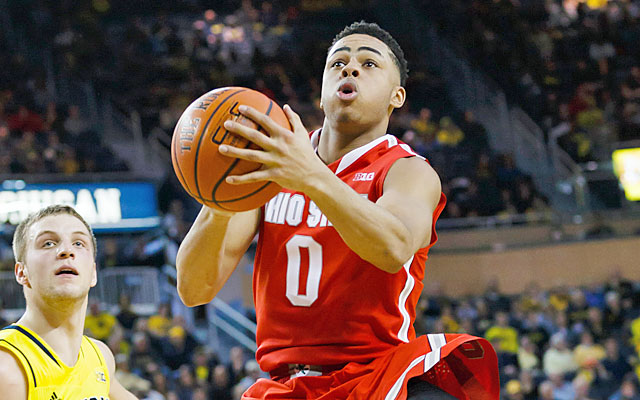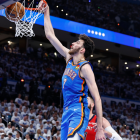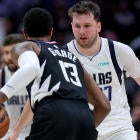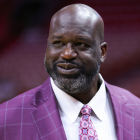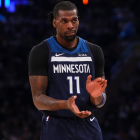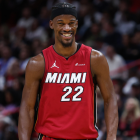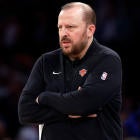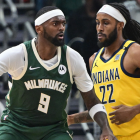"If you are going to make a mistake, make a big mistake."
Around the NBA that means there is such a limited pool of big men that if you have a chance to decide between two prospects who seem to have similar risk, always take the big one.
But that's not what the Lakers should do with their pick at No. 2 in Thursday's NBA draft.
With the Timberwolves apparently taking Kentucky's Karl-Anthony Towns, the Lakers should pass on Duke center Jahlil Okafor and take Ohio State guard D'Angelo Russell with the second pick.
This is counter to the core of what has made the Lakers the second most succesful NBA franchise with 16 NBA titles. The Lakers have a rich tradition of dominant centers -- George Mikan, Wilt Chamberlain, Kareem Abdul-Jabbar, Shaquille O'Neal and Pau Gasol (Granted Pau is a throw in, but he is a borderline Hall of Famer). Big men are as much a part of the fabric of the Laker Forum Blue and Gold as having Jack at courtside. Heck as bad as it was for Dwight Howard, the sell was still that LA is where the BIGGEST stars live, literally and figuratively.
But the NBA has changed and denying that change is falling back into the fatal trap of doing something "because that is what we have always done."
To play center in THIS NBA and play it well you have to defend 3 areas; The post, the rim and the pick and roll/ DHO (dribble hand-offs). Okafor will be fine in the post. He is massive, smart and likes to play physically. BUT, he doesn't block shots like any of the other big men prospects, moves poorly laterally and tires easily.
In fact Miami beat Duke this season by scoring almost 100 points and making Okafor play an NBA type of pace, putting him in a ball screen nearly every possession and playing a high possession game. Okafor couldn't or didn't move much and when he did, it was not good. I'm not saying Okafor stinks, not on offense at the block, but this idea that a back-to-the-basket scorer is the end-all be-all is as dated as a flip phone.
Okafor is an average at best defensive rebounder who also limits the pliability of your roster as you simply have to have both a stretch 4, and one that can cover his weaknesses as a defender. In other words this might only work with Serge Ibaka and maybe four or five other players. The conditioning, the defense, the lateral movement and frankly the defense's ability to push and shove and limit quality post touches is all concerning.
On the other hand there is Russell.
To play point or lead guard like Stephen Curry or James Harden, you have to play well off ball screens, and Curry excels on playing without the ball. Russell is not a freak athletically. He is left-handed, shoots it well off the catch and the dribble and has the vision and creative gene one could guess in the right spread court system could make everyone else better. He is decent defensively, clever off the ball and bigger than Curry on the ball. He seems to have "Play for days" conditioning and he shoots well off the catch and the dribble. He isn't Curry, no one is, but Curry has opened all of our eyes to combo, creative guards with vision and Alpha scoring tendencies.
Quarterback comparison
Did you know there were 11 quarterbacks who threw for 4,000 yards last season in the NFL? NFL teams play at quicker tempos, pass more, the rules are set up to reward offense more, especially passing as like NBA guards, you can't touch WRs or QBs and the stats and styles have reacted in kind.
Quarterbacks, however they rate as prospects, jump up the draft boards as they are just a more valuable commodity. Big men in the NBA are essentially running backs in the NFL. A valuable commodity when healthy, but they do break down more often and though they are helpful in winning big, but you can win without one. Sometimes you are better off having two or three than having just one big man.
Take the Warriors, who had Andrew Bogut, but he barely played at the end of the NBA Finals, as Festus Ezeli and David Lee played center. If you think about it, the Warriors copied the 3-point shooting of the Mike D'Antoni Suns teams and the multiple Center/Running Backs from the championship Saints team. In similar fashion to the NBA, the rules don't allow a defender to hit a QB below the knee or above the neck, and after 5 yards you can't touch a WR. Running backs on the other hand have the bigger, stronger defenders crashing down on them and most linemen are actually more agile than 20 years ago, favoring strength and quickness to pass block over road graters of the past. In other words the rules, the players and the youth/college level offenses that focus on the pass all make it more difficult to be a running back and easier to pass the ball today.
Big guys come along very seldom, especially ones that want to be big guys, and that is Okafor. He is a monster at the low block. He has feel, he will pass, he will compete. But even if we forget about the fact that big guys seem to break down more than guards, we can not get away from the change in the NBA and how the Lakers should adjust accordingly. Kobe Bryant will likely work his way into the post during his last season as his transformation to perimeter shooter, interior post up scorer is very much Jordan-Like, and Okafor would just be in the way. Lakers GM Mitch Kupchak has to look at those banners and know there is a better, newer way.
Don't get me wrong, the NBA has had their share of undersized busts, mid-sized bust and foreign busts, but aren't we watching a total transformation in how basketball is taught, officiated and played over the last decade? And while it is often called "positionless basketball" the one position missing from being of primary concern is a true back-to-the basket player.
And in this draft, the Lakers don't need to go big.
